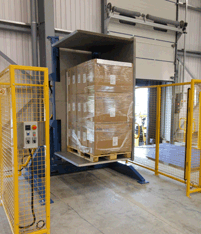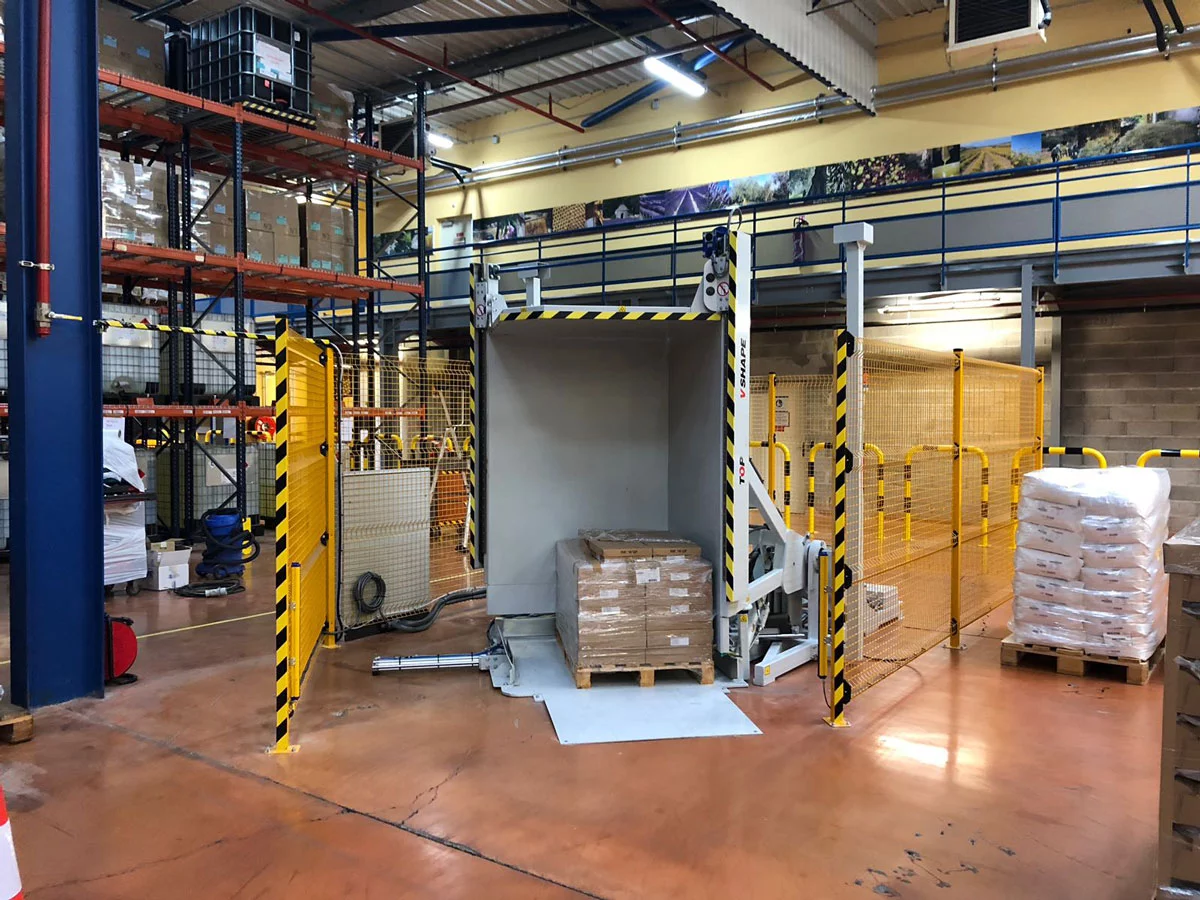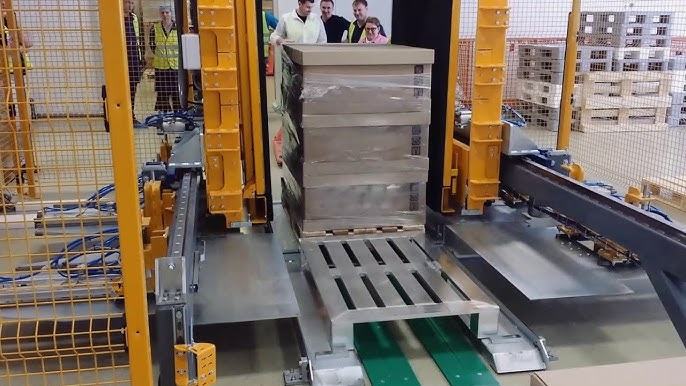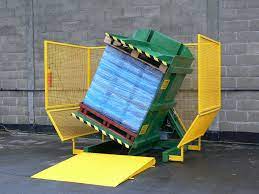Is Your Europe Factory Struggling with Multi-Standard Adaptability Across EU Warehouses? Try a Pallet Changing Machine
Managing logistics across Europe feels like a puzzle with mismatched pieces. You have goods ready to ship, but your warehouse in Germany uses Euro-pallets (EUR), while the destination in the UK requires UK standard pallets. This small difference creates huge headaches. Your team has to manually transfer heavy loads from one pallet to another. This process is slow, risky for your workers, and often leads to damaged products. Every minute spent on manual repalletizing is a minute lost from your production schedule, and every damaged item is a direct hit to your profit margin. It's a persistent, costly problem that many factory owners in Europe simply accept as "the cost of doing business." But it doesn't have to be.
Yes, a pallet changing machine directly solves the problem of multi-standard adaptability for factories in Europe. It automates the process of transferring a full load of goods from one type of pallet, like an in-house or non-compliant pallet, to a destination-compliant one, such as a Euro-pallet or a CHEP pallet. This eliminates manual labor, drastically reduces the risk of product damage, and ensures your shipments meet the specific requirements of different warehouses and logistics networks across the EU.

I've seen this issue firsthand for over two decades in the packaging industry. I remember visiting a client in Spain whose business was expanding into France and Germany. They were celebrating their growth, but their warehouse manager was stressed. His team was spending hours each day physically moving boxes from Spanish pallets to Euro-pallets. It was a bottleneck that slowed down their entire operation. This isn't a unique story. It's a common challenge that many successful, growing businesses in Europe face. The solution is often simpler and more effective than you might think. Let's break down how a dedicated machine can solve these specific challenges and deliver a strong return on your investment.
How does a pallet changing machine solve EU-specific logistics challenges?
Your goods are crossing borders, and suddenly, the simple wooden platform they sit on becomes a major compliance issue. A pallet that’s perfect for your factory in Poland might be rejected at a distribution center in the UK or a high-tech warehouse in the Netherlands. This forces your team into a costly, inefficient fire-fighting mode, manually restacking goods. This isn't just inefficient; it's a systemic problem in European logistics caused by a lack of a single, universal standard. So, how can a single piece of equipment act as a universal translator for your products?
A pallet changing machine solves these EU-specific logistics challenges by creating a standardized, automated bridge between different pallet standards. It allows you to receive goods on any pallet, or use cost-effective in-house pallets for production, and then seamlessly transfer the entire load to a certified Euro-pallet, a UK-standard pallet, or a rental pallet like a CHEP or LPR, right before shipping. This ensures every shipment complies with the destination's requirements without manual intervention.

Dive Deeper: From Bottleneck to Bridge
The core issue in European logistics isn't just about different pallet sizes. It's a combination of dimensions, materials, and regulations that vary from country to country and even from industry to industry. A pallet changer addresses each of these layers.
First, let's consider the physical standards. The most common pallets in the EU have distinct differences that make them incompatible with certain automated warehousing systems or transport configurations.
| Pallet Type | Dimensions (mm) | Common Regions/Uses | Key Characteristics |
|---|---|---|---|
| EUR/EPAL Pallet | 1200 x 800 | Mainland Europe | The de-facto standard. Required by many retailers and logistics providers. Four-way entry. |
| UK Standard Pallet | 1200 x 1000 | United Kingdom | Larger footprint. Also common for specific industries like chemicals and FMCG. |
| CHEP/LPR Pallets | Various (often 1200x800 or 1200x1000) | EU-wide (Rental) | Distinctive blue (CHEP) or red (LPR) color. Part of a pooling system; you rent them. |
| Half Pallet | 800 x 600 | Retail, Display | Used for point-of-sale displays. Requires transfer from a standard pallet. |
A pallet changing machine doesn't care about these differences. Whether you need to switch from a 1200x1000 pallet to a 1200x800, the machine handles it. For example, a "pallet inverter" clamps the load, rotates it 180 degrees, allows the old pallet to be removed from the top, and then places the new pallet before rotating back. A "pusher-type" changer gently pushes the entire product stack from the source pallet to the destination pallet. This mechanical process is far more reliable and faster than any manual team.
Second, there is the issue of material and treatment regulations, specifically ISPM 15. This international standard requires that wood packaging material (WPM), including pallets, be heat-treated or fumigated to prevent the spread of pests. If your goods arrive at a border on a non-compliant wooden pallet, your entire shipment can be quarantined or rejected. Many factories use internal, untreated, or plastic pallets for hygiene and cost reasons. A pallet changer allows you to use these internal pallets throughout your facility and then switch to a fully compliant, ISPM 15-stamped wooden pallet only for the final outbound shipment. This isolates your internal processes from external regulatory risks.
What are the ROI and operational benefits of automating pallet transfers?
As a factory owner, every investment must be justified. You look at a new machine and see a capital expense. But I urge you to look at your current process and see the hidden costs. How much are you spending on labor for manual repalletizing? What is the cost of one major back injury to an employee? How much revenue is lost when a shipment is delayed or a product is damaged? These are the real costs that a pallet changer targets. The initial investment can seem significant, but the return on investment (ROI) is often surprisingly fast and multifaceted.
The ROI for a pallet changing machine comes from direct cost savings in labor, reduced product damage, and fewer workplace injuries. The operational benefits extend to much faster throughput, improved warehouse organization, and enhanced compliance, which together boost overall efficiency and profitability. Many of my clients see a payback period of 12 to 24 months.

Dive Deeper: Calculating the True Return
Let's move beyond generalities and look at how someone like Javier Morales, the steel mill owner, would analyze this. He is focused on tangible numbers and operational stability. The ROI calculation for a pallet changer is a straightforward exercise that every manager should perform.
1. Labor Cost Savings:
This is the most direct saving. Let's assume you have two workers spending four hours each day on manual repalletizing.
- Total labor hours per day: 2 workers * 4 hours = 8 hours
- Average labor cost in Europe (including overheads): €25/hour
- Daily cost of manual repalletizing: 8 hours * €25/hour = €200
- Annual cost (assuming 250 working days): €200 * 250 = €50,000
A pallet changer can reduce this time by over 90%. The task of loading and unloading the machine might take one worker less than 30 minutes per day. The annual labor saving is substantial.
2. Reduction in Product Damage:
Manual handling is imprecise. Boxes get dropped, bags tear, and containers get dented. A conservative estimate for product damage during manual transfer is 1-2% of the value of the goods handled. A pallet changer handles the entire load as a single, stable block, reducing damage to nearly zero.
- If you transfer €2 million worth of goods per year this way, a 1% damage rate costs you €20,000 annually. Automating this process recovers that loss.
3. Workplace Safety and Injury Prevention:
The cost of a single serious back injury can be enormous, including medical expenses, insurance premium hikes, lost productivity, and potential legal fees. According to Eurostat, sprains and strains are among the most common non-fatal workplace accidents. By automating the heavy lifting, you practically eliminate this risk. While harder to quantify on a spreadsheet before an accident happens, this is a massive financial and ethical benefit.
Here is a simplified ROI table:
| Benefit Category | Manual Process (Annual Cost) | Automated Process (Annual Cost) | Annual Savings |
|---|---|---|---|
| Labor | €50,000 | €5,000 (Supervision) | €45,000 |
| Product Damage | €20,000 | < €1,000 | €19,000 |
| Injury Risk | High (Potential >€30,000/incident) | Very Low | Significant Risk Mitigation |
| Total Direct Savings | €64,000 |
If the pallet changer costs, for example, €80,000, the payback period based on direct savings alone is just over 15 months. This calculation doesn't even include the operational benefits like faster truck turnaround times, increased capacity, and the ability to meet the demands of major retailers who require specific pallet types. For a leader aiming to cut operational costs by 8%, this is a clear, actionable step.
How do you integrate a pallet changer into an existing production line without major downtime?
This is a very practical and important question. The thought of stopping production to install a new piece of equipment is daunting for any factory manager. You have orders to fulfill and schedules to meet. A long, complicated installation process can feel more disruptive than the problem it's trying to solve. You might worry about clearing space, rerouting workflows, and extensive training, all while your production numbers fall. So, is it possible to add this capability without turning your factory upside down for weeks?
Integrating a pallet changer into an existing line with minimal downtime is achieved through careful planning, modular machine design, and scheduled installation during off-peak hours. Most pallet changers are designed as standalone, self-contained units that can be installed and commissioned over a weekend or during a short, planned maintenance shutdown, avoiding major disruption to your core operations.

Dive Deeper: A Phased Approach to Seamless Integration
From my experience helping factories implement this equipment, success lies in a structured, phased approach. It's not about just dropping a machine on the floor. It's about thoughtful integration.
Phase 1: Workflow Analysis and Layout Planning (The Blueprint)
Before any machine is ordered, the first step is a thorough analysis of your current workflow. We ask questions like:
- Where is the pallet transfer happening now?
- What is the flow of goods from production to the loading bay?
- How much space is available?
- Will this be a standalone station served by forklifts, or does it need to be connected to conveyors?
The goal is to find the most logical place for the pallet changer. Often, this is near the wrapping machine or in the outbound staging area. Because most pallet changers have a relatively small footprint, they can often fit into existing layouts without major changes. We create a simple 2D layout to show exactly where the machine will go and how forklifts or personnel will interact with it.
Phase 2: Pre-Installation Preparation (The Foundation)
This is the key to a fast installation. While the machine is being manufactured, your team can prepare the site. This usually involves two simple tasks:
- Power Supply: Ensuring a suitable electrical connection is available at the location.
- Floor Surface: Confirming the concrete floor is level and can support the machine's weight.
These preparations are done during normal working hours and have zero impact on production. The machine arrives ready to be "plugged in."
Phase 3: Installation and Commissioning (The Weekend Job)
This is the part that most managers worry about, but it's often the quickest phase. We schedule the physical installation for a non-production period, like a Saturday or a planned maintenance day.
- Positioning: The machine, often shipped as a single unit or two large modules, is positioned with a forklift.
- Hook-up: Electrical and, if necessary, pneumatic connections are made.
- Testing: We run a series of tests with empty and full pallets to ensure all mechanical and safety functions are working perfectly. This includes setting clamping pressures and cycle speeds.
A standard standalone installation can typically be completed in one or two days.
Phase 4: Training and Handover
On the first day of operation, our engineer or a trained partner will be on-site to train your operators and maintenance staff. The training is straightforward: how to safely operate the machine, how to read the control panel, and how to perform basic daily checks. This ensures your team is confident and self-sufficient from day one. This partnership approach is critical. We don't just sell a machine; we deliver a working solution.
What are the safety and quality control considerations for pallet changers?
You are solving a logistics problem, but you cannot create a new safety or quality problem in its place. Introducing any new automated equipment into your factory requires a deep look at how it impacts your people and your products. What prevents an operator from getting hurt? And how can you be sure that the machine won't crush, drop, or damage the very goods it's supposed to be handling carefully? A machine that speeds up your process but compromises safety or quality is not a solution; it's a liability.
Modern pallet changers are designed with safety and quality as primary considerations. Safety is ensured through physical guards, light curtains, and emergency stop systems that comply with EU standards (like CE marking). Quality control is managed through adjustable clamping pressures and smooth, controlled movements to handle a wide variety of products—from robust steel parts to fragile boxes—without causing damage.

Dive Deeper: Engineering for Safety and Product Integrity
When I discuss these machines with clients, I emphasize that the engineering behind them is focused on two equal goals: protecting people and protecting products.
1. Protecting Your People: A Multi-Layered Safety System
Compliance with European safety directives is non-negotiable. A properly designed pallet changer incorporates several layers of safety, making it one of the safer pieces of equipment on the factory floor.
- Physical Guarding: The entire operating area is enclosed in high-strength safety fencing. This physically prevents anyone from accidentally walking into the machine's path while it's in motion.
- Interlocked Doors: Access doors to the enclosure are fitted with safety interlocks. If a door is opened, the machine immediately stops its cycle and cannot be restarted until the door is closed and the system is reset.
- Light Curtains: At the entry and exit points where forklifts load and unload pallets, infrared light curtains create an invisible safety barrier. If any object (a person, a forklift mast) breaks this barrier during a cycle, the machine halts instantly. This is a critical feature for semi-automated operations.
- Emergency Stops (E-Stops): Multiple, easily accessible E-stop buttons are placed around the machine. Pressing any of these will immediately cut power to the motors.
- CE Marking: Always look for the CE mark. This indicates that the manufacturer has certified that the machine meets the EU's high safety, health, and environmental protection requirements.
2. Protecting Your Products: Gentle Power and Smart Control
A pallet changer must be strong enough to lift over a ton of material but gentle enough not to damage a single box. This is achieved through intelligent design and adjustable controls.
- Adjustable Clamping Pressure: This is perhaps the most important quality control feature. The control system allows you to set the precise amount of pressure the clamping walls apply to the load. For a stack of heavy, solid steel parts, you can use high pressure. For a pallet of delicate food packaging or electronic components, you can reduce the pressure to provide just enough support to hold the load securely without crushing it. We often help clients create preset "recipes" for their different product types.
- Smooth, Controlled Motion: The rotation or pushing mechanism is driven by powerful but smooth hydraulic or electric motors. The acceleration and deceleration are controlled to prevent sudden jerks that could shift the load and cause products to fall or knock against each other.
- Full Load Support: In a pallet inverter, the load is supported on all sides (bottom, top, and two sides) during the entire 180-degree rotation. This prevents the stack from losing its shape or integrity, which is especially important for products that are not perfectly uniform, like bags of material.
For a business owner like Javier, whose reputation is built on quality, these features are not just nice to have; they are essential. They ensure that improving efficiency in the warehouse doesn't come at the cost of the high-quality steel products his customers expect.
My Insight: Beyond the Machine, A Pallet Changer is a Commitment to Smarter, Leaner Operations
Over the years, I have sold many machines. But the conversations I value most are not about specifications or prices. They are about transformation. When I see a factory owner's eyes light up, it’s because they don't just see a pallet changer. They see a solution to a problem that has plagued their team for years. They see a safer workplace. They see an end to a major bottleneck.
I started my career on the factory floor. I've manually lifted heavy parts and I've seen the physical toll it takes on good, hardworking people. I remember watching two colleagues struggle to transfer a large stack of wire coils from a broken pallet. It was slow, dangerous work. That memory has always stayed with me. It’s why I am so passionate about providing solutions that do more than just improve a metric on a spreadsheet. A machine like a pallet changer is a direct investment in your people's well-being. It removes a physically demanding, repetitive, and unfulfilling job, freeing up your team to focus on more valuable tasks that require human skill and intelligence.
This isn't just about operational improvement; it's about embracing a Lean Manufacturing philosophy. The core principle of Lean is the elimination of "muda," or waste. Manual repalletizing is a classic example of waste: wasted motion, wasted time, and the waste of potential product damage. By automating this task, you are not just buying a machine; you are embedding a leaner, smarter way of thinking into your operations.
For a forward-thinking leader, an investment like this is a stepping stone. It's a tangible move towards the kind of digitized, efficient factory they envision. It solves a real, physical-world problem today, while aligning perfectly with long-term goals like improved safety, higher throughput, and reduced operational costs. It’s a practical decision that sends a powerful message to your entire organization: we work smart, not just hard.
Conclusion
A pallet changing machine solves Europe's multi-standard pallet problem, boosting efficiency, safety, and your bottom line. It is a smart, strategic investment for any forward-thinking factory.


